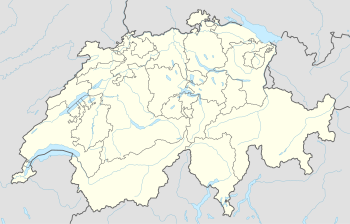Lucens reactor: Difference between revisions
m fix insc.anl.gov link using MementoWeb |
Cyberbot II (talk | contribs) Rescuing 1 sources, flagging 0 as dead, and archiving 3 sources. #IABot |
||
| Line 4: | Line 4: | ||
The '''Lucens reactor''' at [[Lucens]], [[Vaud]], Switzerland, was a small [[pilot plant|pilot]] [[nuclear reactor]] destroyed by an [[nuclear accident|accident]] in 1969. |
The '''Lucens reactor''' at [[Lucens]], [[Vaud]], Switzerland, was a small [[pilot plant|pilot]] [[nuclear reactor]] destroyed by an [[nuclear accident|accident]] in 1969. |
||
In 1962 the construction of a Swiss-designed [[pilot plant|pilot]] [[nuclear power plant]] began. The [[heavy-water reactor|heavy-water]] moderated, [[carbon dioxide]] [[gas-cooled reactor types|gas-cooled]], reactor was built in an underground [[cave]]rn<ref>[http://www.sapierr.net/files1/results_swiss.htm Summary of Swiss nuclear reactors], SAPIERR Support Action: Pilot Initiative for European Regional Repositories {{ |
In 1962 the construction of a Swiss-designed [[pilot plant|pilot]] [[nuclear power plant]] began. The [[heavy-water reactor|heavy-water]] moderated, [[carbon dioxide]] [[gas-cooled reactor types|gas-cooled]], reactor was built in an underground [[cave]]rn<ref>[http://www.sapierr.net/files1/results_swiss.htm Summary of Swiss nuclear reactors], SAPIERR Support Action: Pilot Initiative for European Regional Repositories {{wayback|url=http://www.sapierr.net/files1/results_swiss.htm |date=20110719140734 }}</ref> and produced 30 [[megawatt]]s of heat (which was used to generate 8.3 megawatts of electricity).<ref>[http://www.nea.fr/html/general/profiles/switzerland.html Swiss nuclear power], French Nuclear Energy Agency</ref> It became critical in 1966 and the plant was decommissioned in 1988.<ref>{{cite paper|title=On-site disposal as a decommissioning strategy|url=http://www-pub.iaea.org/MTCD/publications/PDF/te_1124_prn.pdf|publisher=International Atomic Energy Agency|accessdate=6 January 2013|page=67|date=November 1999}}</ref> It was fueled by 0.96% [[enriched uranium]] alloyed with [[chromium]] cased in [[magnesium]] alloy (magnesium with 0.6% [[zirconium]]) inserted into a [[nuclear graphite|graphite]] matrix. Carbon dioxide gas was pumped into the top of the channels at 6.28 MPa and 223 °C and exited the channels at a pressure of 5.79 MPa and at a temperature of 378 °C. |
||
It was intended to operate until the end of 1969, but during a startup on January 21, 1969, it suffered a [[loss-of-coolant accident]], leading to a partial [[core meltdown]] and massive [[radioactive contamination]] of the cavern, which was then sealed. |
It was intended to operate until the end of 1969, but during a startup on January 21, 1969, it suffered a [[loss-of-coolant accident]], leading to a partial [[core meltdown]] and massive [[radioactive contamination]] of the cavern, which was then sealed. |
||
Revision as of 13:52, 11 January 2016
The Lucens reactor at Lucens, Vaud, Switzerland, was a small pilot nuclear reactor destroyed by an accident in 1969.
In 1962 the construction of a Swiss-designed pilot nuclear power plant began. The heavy-water moderated, carbon dioxide gas-cooled, reactor was built in an underground cavern[1] and produced 30 megawatts of heat (which was used to generate 8.3 megawatts of electricity).[2] It became critical in 1966 and the plant was decommissioned in 1988.[3] It was fueled by 0.96% enriched uranium alloyed with chromium cased in magnesium alloy (magnesium with 0.6% zirconium) inserted into a graphite matrix. Carbon dioxide gas was pumped into the top of the channels at 6.28 MPa and 223 °C and exited the channels at a pressure of 5.79 MPa and at a temperature of 378 °C.
It was intended to operate until the end of 1969, but during a startup on January 21, 1969, it suffered a loss-of-coolant accident, leading to a partial core meltdown and massive radioactive contamination of the cavern, which was then sealed.
The accident was caused by water condensation forming on some of the magnesium alloy fuel element components during shutdown and corroding them. The corrosion products from this accumulated in some of the fuel channels. One of the 73 vertical fuel channels was sufficiently blocked by it to impede the flow of carbon dioxide coolant so that the magnesium alloy cladding melted and further blocked the channel. The increase in temperature and exposure of the uranium metal fuel to the coolant eventually caused the fuel to catch fire in the carbon dioxide coolant atmosphere. The pressure tube surrounding the fuel channel split because of overheating and bowing of the burning fuel assembly, and the carbon dioxide coolant leaked out of the reactor.[4][5]
No irradiation of workers or the population occurred, though the cavern containing the reactor was seriously contaminated. The cavern was decontaminated and the reactor dismantled over the next few years.
References
- ^ Summary of Swiss nuclear reactors, SAPIERR Support Action: Pilot Initiative for European Regional Repositories Template:Wayback
- ^ Swiss nuclear power, French Nuclear Energy Agency
- ^ "On-site disposal as a decommissioning strategy" (PDF). International Atomic Energy Agency. November 1999: 67. Retrieved January 6, 2013.
{{cite journal}}: Cite journal requires|journal=(help) - ^ Description of events, Nuclear tourist
- ^ Heavy water reactors: Status and projected development, IAEA, 2002
See also
External links
- Science and technology in Switzerland
- Nuclear technology in Switzerland
- Former nuclear power stations
- Nuclear power stations in Switzerland
- Nuclear accidents and incidents
- Buildings and structures in Vaud
- Radioactively contaminated areas
- 1966 establishments in Switzerland
- 1969 disestablishments
- Defunct nuclear reactors

